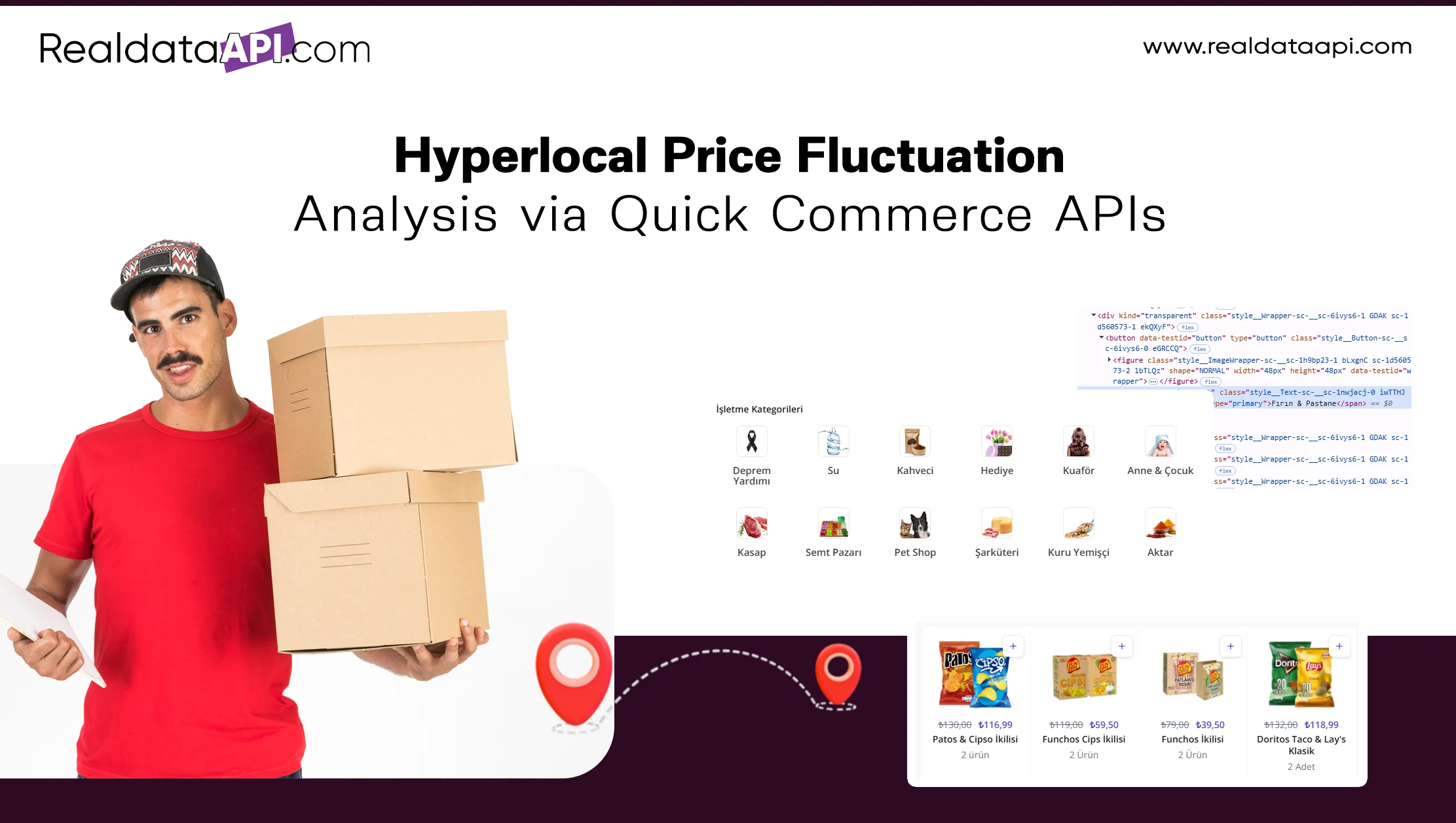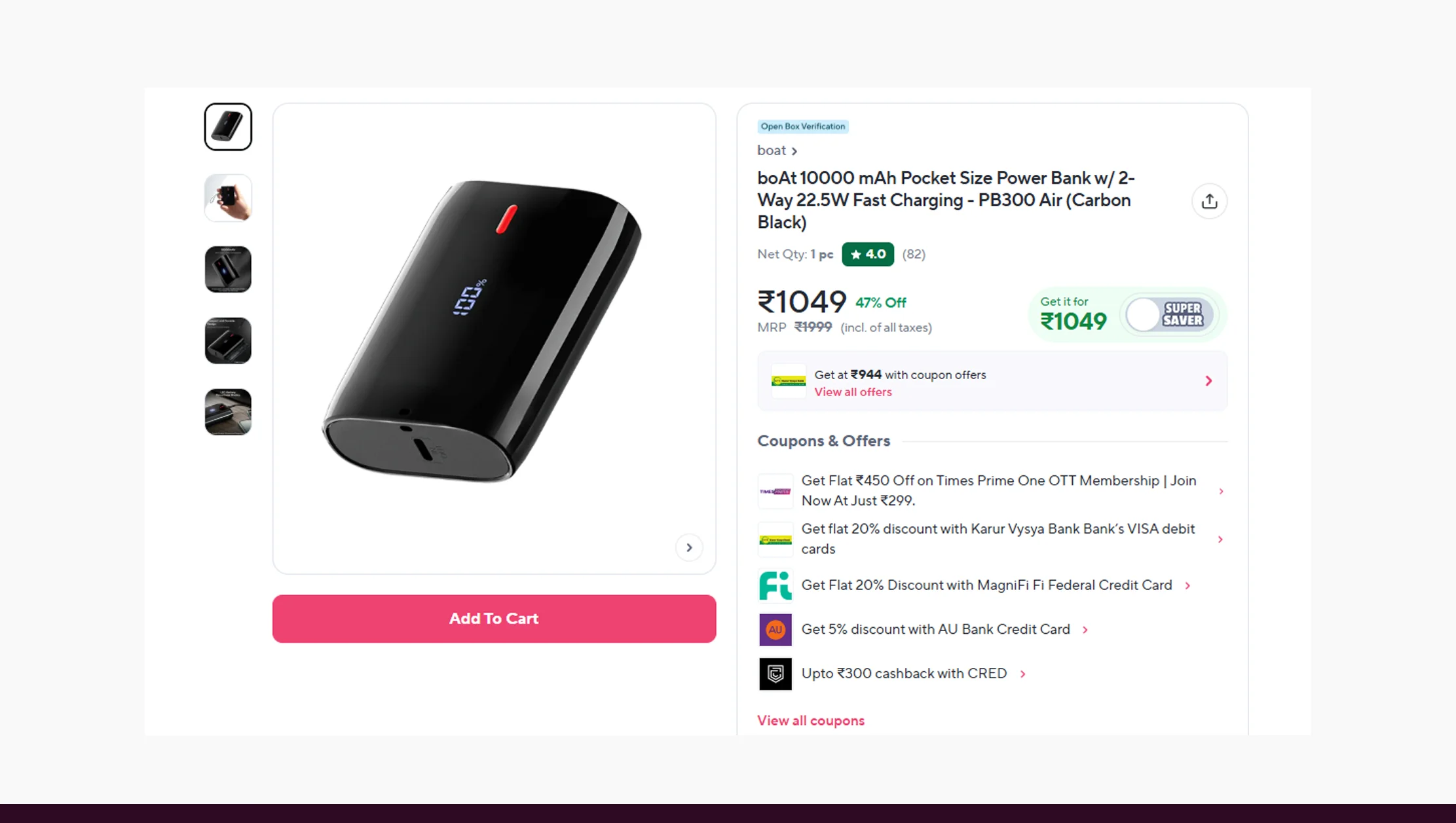

Introduction
In today’s digitized retail landscape, hyperlocal pricing has become a key differentiator in how brands compete, market, and retain customers. Thanks to the rise of quick commerce platforms like Blinkit, Zepto, Getir, and Gorillas, pricing no longer follows a static national model—it’s dynamic, localized, and frequently updated based on supply-demand, local inventory, and customer behavior.
But how do businesses monitor, analyze, and respond to these hyperlocal price fluctuations? The answer lies in the use of Quick Commerce APIs and data scraping tools that offer real-time insights into item-level price changes across regions, cities, or even neighborhoods.
In this blog, we’ll explore how hyperlocal price analysis works, how to access this data via APIs, and what it means for brands, retailers, analysts, and competitors—ending with a smart solution from Real Data API for actionable insights.
What is Hyperlocal Pricing?

Hyperlocal pricing refers to adjusting product prices based on localized variables such as:
- Geographic region
- Local inventory levels
- Competitor pricing in the vicinity
- Customer demand in specific zip codes
- Time-sensitive factors like time of day, festival, or weather
For example, a soft drink might cost ₹38 in Mumbai’s Andheri West but ₹42 in South Delhi on Blinkit, due to localized inventory costs and consumer trends.
Why Hyperlocal Pricing Matters in Quick Commerce?

The success of 10-minute delivery platforms depends on micro-warehousing and decentralized inventory management. This leads to different pricing strategies per location. Here’s why tracking these fluctuations is crucial:
For Brands:
- Detect pricing inconsistencies by third-party sellers
- Ensure promotional offers are regionally consistent
- Monitor MAP (Minimum Advertised Price) enforcement
For Retailers:
- Benchmark your price against competitors in real-time
- Avoid underpricing or overpricing in certain zones
- Set dynamic pricing rules by region
For Consumers:
- Understand pricing transparency across delivery apps
- Save by switching regions (e.g., home vs office location)
Stay ahead in fast delivery retail—leverage hyperlocal pricing to boost margins, match demand, and outpace competitors in every ZIP code!
Get Insights Now!How Quick Commerce Platforms Enable Hyperlocal Pricing?

Quick commerce apps like Blinkit, Zepto, Getir, and Gorillas rely heavily on APIs to deliver real-time pricing data to customers. These APIs fetch:
- Product availability
- Real-time price per item
- Offers & discounts per pin code
- Delivery charges (variable by area)
- Substitute product pricing
Because this pricing is calculated at the fulfillment center level, each API call varies by user’s location, device ID, or delivery address.
Key APIs Involved in Price Tracking
Quick commerce apps use multiple API endpoints behind the scenes to serve dynamic content. These include:
1. Product Price API
- Fetches product ID, price, discount, and availability based on user’s location
- Endpoint: /api/v1/products?lat=28.6139&lng=77.2090
- Fields: product_id, price, original_price, discount, warehouse_id
2. Location-Aware Search API
- Returns search results based on hyperlocal inventory
- Endpoint: /api/search?q=milk&lat=19.0760&lng=72.8777
- Includes price variance between similar SKUs
3. Zone Pricing API
- Returns the same product list but different pricing based on selected zone or pincode
- Useful for comparing price shifts between cities or delivery hubs
4. Category-Level APIs
- Pulls multiple items per category (e.g., snacks, beverages) for bulk price comparison
- Allows scraping hundreds of SKUs by category + location matrix
Platforms Analyzed: Zepto, Blinkit, Getir, Gorillas
Let’s explore how these platforms behave when it comes to hyperlocal price data:
Zepto (India)
.webp)
Zepto operates from dark stores that cater to tightly zoned delivery areas. Each store prices items slightly differently based on cost structure and competition.
- API Behavior: Pricing changes across pin codes for the same product ID
- Dynamic Promotions: Region-specific bundle offers and limited-time discounts
- Scraping Strategy: Rotate zip codes and compare product catalog JSON responses
Use Case: Monitor grocery price inflation across cities like Mumbai, Bengaluru, Delhi in real-time.
Blinkit (India)
.webp)
Blinkit heavily localizes its grocery pricing. In high-demand areas, discounts may be lower to protect margins.
- API Behavior: Price visibility tied to geolocation or selected delivery address
- Unique Feature: Shows “Price Slashed” tags per SKU in select zones
- Scraping Strategy: Use device headers + address rotation to fetch data from multiple zones
Use Case: Identify regions where promotions are not honored or vary from marketing claims.
Getir (Europe, U.S.)
.webp)
Getir’s catalog pricing differs by country and city. Istanbul pricing is vastly different from London or Chicago.
- API Behavior: Country and zip-code-based pricing differentiation
- Unique Feature: Country-specific inventory + dynamic pricing by order history
- Scraping Strategy: Rotate proxy IPs + simulate local mobile sessions
Use Case: Conduct European city-level pricing parity analysis for global brands.
Gorillas (EU Cities)
.webp)
Gorillas uses warehouse-specific pricing. The same product may be priced differently even in neighboring Berlin zones.
- API Behavior: Dynamic pricing logic based on city zones, promotions
- Scraping Strategy: Bulk pull category data and sort by warehouse zone
- Unique Feature: Per-zone tax and handling charges impact final cart value
Use Case: Audit if tax-inclusive pricing is being uniformly calculated.
Analyze Zepto, Blinkit, Getir & Gorillas pricing data—gain real-time insights to optimize strategy, boost competitiveness, and grow market share fast!
Get Insights Now!How to Scrape Hyperlocal Pricing Data?

Scraping hyperlocal pricing data from quick commerce platforms requires advanced scraping methodologies due to:
- Geolocation dependencies
- Session-specific tokens
- Obfuscated product IDs
Key Tools:
- Python + Requests/BeautifulSoup (for simple GET APIs)
- Playwright or Puppeteer (for JavaScript-rendered pricing)
- Android Emulator + Packet Capture Tools (to reverse engineer app APIs)
- Residential Proxy Network (to rotate IPs per delivery zone)
Sample Scraping Workflow

Collect Zip Codes: Curate a list of all serviceable pin codes per city.
Build API Requests: Automate API calls with rotated geo-coordinates.
Extract Fields:
- Product Name
- Price
- Discount %
- Stock status
- SKU code
Store Data: Use Pandas DataFrame + CSV/JSON or push to a database.
Compare Pricing: Use visualization tools (Tableau, Power BI) to plot city-wise variation.
Real-Time Use Cases of Hyperlocal Price Analytics
1. Competitive Price Benchmarking
Brands can compare their product pricing across platforms and cities to ensure fair play and identify rogue sellers or inconsistent promotions.
2. Dynamic Pricing Strategy
Retailers can adjust their own prices using scraped competitor data to stay competitive per neighborhood or zip code.
3. Omnichannel Pricing Alignment
Helps ensure pricing parity between offline store pricing and quick commerce platforms for the same SKUs.
4. Geo-Specific Demand Forecasting
Link price elasticity with demand zones. If discounts increase sales in Zone A but not in Zone B, campaigns can be fine-tuned.
5. Compliance and MAP Monitoring
Brands can ensure their Minimum Advertised Price is respected by partner platforms and resellers—especially important in marketplaces like Zepto and Blinkit.
Sample Data Table (Milk Price Across Cities)
| Product | Delhi Price | Mumbai Price | Bangalore Price | Discount |
|---|---|---|---|---|
| Amul Toned Milk 1L |
₹58 | ₹55 | ₹56 | 5% |
| Mother Dairy 1L | ₹59 | ₹60 | ₹58 | 0% |
| Aavin Milk 500ml |
₹28 | N/A | ₹26 | 10% |
Visualization Idea
Visualization Idea A heatmap of product prices by city and zone for top 10 FMCG items can reveal:
- Pricing hotspots
- Discount clusters
- Inflation trends
- Regional offer discrepancies
Ethical Considerations & Technical Challenges

Anti-Bot Systems
Platforms may detect scraping and block IPs.
Solution: Use delay timers, proxy rotation, and respect rate limits.
API Authentication
APIs may use dynamic headers, tokens, or JWT authentication.
Solution: Capture live headers using tools like Fiddler or Charles Proxy, and automate renewal.
Geo-Spoofing
Need to simulate different delivery zones for accurate pricing.
Solution: Use mobile device emulators with location override or GPS spoofing tools.
Future of Hyperlocal Pricing Analytics

As competition in the quick commerce space intensifies, expect:
- More granular zone-level pricing
- AI-based dynamic repricing by platforms
- Real-time public API dashboards by brands
- Automated price matching bots
- Region-based loyalty pricing
Conclusion
Hyperlocal price tracking is no longer optional—it’s essential for competitive survival, revenue optimization, and consumer trust.
Whether you’re a brand manager, retailer, pricing analyst, or investor, getting access to accurate, geo-targeted pricing data in real-time is crucial.
This is where Real Data API excels.
Real Data API provides enterprise-grade scraping and data extraction solutions specifically tailored for quick commerce platforms like Blinkit, Zepto, Getir, and Gorillas. From real-time hyperlocal pricing feeds to historical price movement analysis across cities, Real Data API delivers scalable, legal, and efficient pricing intelligence for businesses across sectors.













